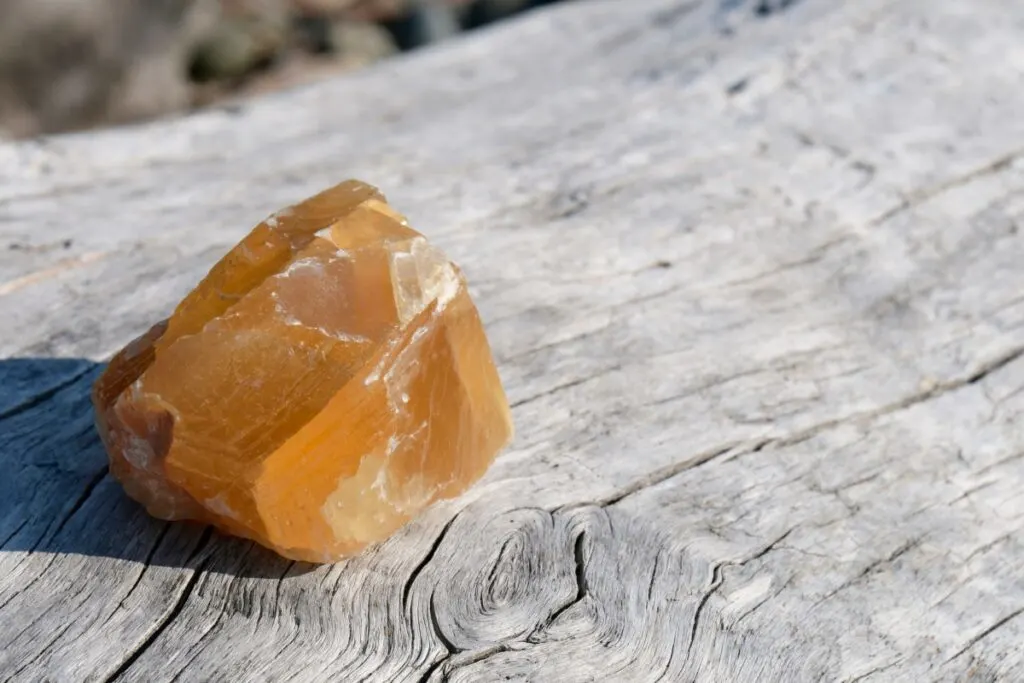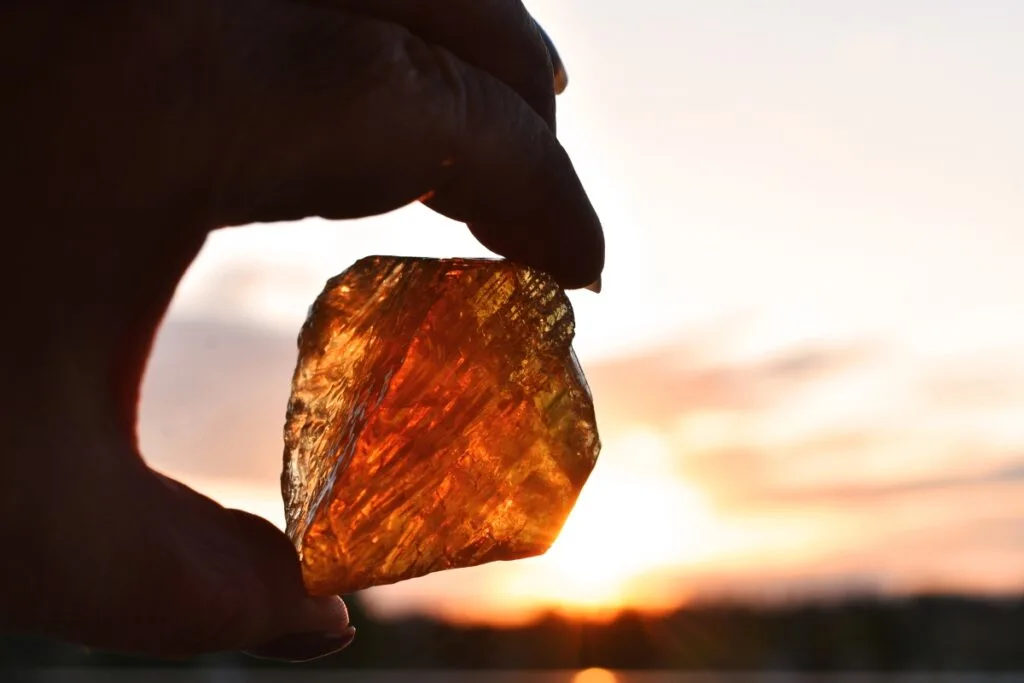As an Amazon Associate, I earn from qualifying purchases with no additional costs for you.
Calcite is quite a widespread mineral that many rockhounds seek to have in their collection. In some instances, you can even find calcite geodes if you are lucky! Calcite is often a component of limestone, as it occurs mainly in sedimentary settings.
In the U.S., you can find calcite in many states. Utah, Missouri, Tennessee, and Indiana are some of the best U.S. states to find this mineral. Calcite is found in various environments as it forms in shallow marine settings, hydrothermal veins, hot spring deposits, or, as previously mentioned, most sedimentary settings.
If you wish to find calcite minerals in nature, you must first understand how it forms and what are the most common environments you should start searching for. Let’s see precisely how calcite forms and what are some of the best locations to find it in different U.S. states!

If you are interested in checking out the best books about rock and minerals identification, you can find them by clicking here (Amazon link).
Where to Find Calcite Near Me (Most Common Environments)
Calcite forms in many ways. One standard formation procedure is through direct precipitation of waters rich in calcium.
Calcite also comes from the shells of dead marine organisms, which is why it is often found as a component of sedimentary rocks, such as limestone or metamorphic marble specimens.
A great environment example where calcite is commonly found in the Snowy River Cave in New Mexico, where countless dead microorganisms contributed to the natural formations of the cave.
Calcite is also commonly found in mines and mine dumps, quarries, mountain ranges, washes and draws, canyons, pits, or gravels.
Although you can find calcite minerals in nature, you can also find calcite crystals. Let’s examine some of these environments and see why calcite is often found in them!
Mines, Mine Dumps, Quarries, and Pits
Many calcite deposits are found underground at small depths a couple of miles. Because of this, mines, mine dumps, quarries, or pits are some of the most excellent locations you can find calcite minerals or crystals.
Mountain Ranges and Canyons
Canyons or mountain ranges are also great places to search for calcite specimens. Due to how canyons are structured, they often reveal calcite locations, and mountain ranges also do this by elevating calcite deposits at the surface levels.
Washes and Draws, Gravels
Lastly, washes and draws, or gravels, are also favorable environments where you may find calcite specimens. This is because calcite often occurs in sedimentary settings.
TIP: Generally, tumbling calcite isn’t necessary because even rough, it shows the mineral properties and markings. Find out more about tumbling calcite in the article below:
Can You Tumble Calcite? Be Careful and Follow These Tips!
Where Is Calcite Found in the U.S.? The Best Locations

There are many varieties of calcite in the world, and several of them can be found in the U.S. Not all U.S. states have calcite. Some have certain types of calcite minerals, and others have different varieties of calcite crystals. Some have both.
The best U.S. states to find calcite minerals and crystals are Utah, Kansas, Missouri, Wisconsin, Illinois, Tennessee, Indiana, Kentucky, Connecticut, Pennsylvania, Virginia, North Carolina, Florida, New Jersey, Vermont, and Ohio, among others. No U.S. state has calcite as its official state mineral or crystal.
| State | Locations |
|---|---|
| Florida | Chipley, Crystal River, Brooksville |
| Connecticut | Bristol Copper Mine, Meriden, Pine Rock Quarry |
| Ohio | Conneaut, Genoa, Sandusky |
Let’s examine some of these U.S. states and see where you can find calcite minerals and crystals!
Utah
Utah is a fantastic state when it comes to calcite specimens. If you are near Salt Lake, visit Box Elder County. Here, you can find beautiful calcite specimens in the mining district around Crater Island.
Salt Lake County is also where Bingham Canyon is located, where calcite is found in the large open pit mines. If you are near Tooele County, visit the Clifton Mining District. The area mines are filled with calcite specimens or go to Johnson Pass.
Utah County has the Wells Canyon, a fantastic place to find calcite, and the East Tintic Mountains. Explore the general area to find calcite. In Northeastern Utah, go to Summit County, and visit the Park City Mining District. Here, most of the mines and mine dumps are filled with calcite.
Grand County is a fantastic place to find calcite as well. The general area around Courthouse Wash is a great place to start looking. Visit The Needles, Tenmile Wash, or Miner’s Basin, and explore the area mines.
Western Utah also has excellent calcite rockhounding locations, such as Juab County. There, head to Thomas Range, and you will find calcite on the northern side. The Topaz Dome Quarry also has calcite. In Sevier County, you can find calcite at the Henry Mining District, specifically at Antelope Range.
In Southern Utah, you can find calcite in Beaver County at the area mines around Indian Peak Star Range or Lincoln Gulch. Fluorescent calcite specimens are found in Piute County, in the Tushar Mountains.
TIP: For a complete rockhounding guide in Utah, check out this article.
BTW: Do you want to know more about rock and mineral identification? The books listed below are the best ones you can find on the internet (Amazon links):
- Smithsonian Handbooks: Rocks & Minerals
- Gemstone & Crystal Properties (Quick Study Home)
- Ultimate Explorer Field Guide: Rocks and Minerals (National Geographic Kids)
Missouri
The state of Missouri is generally regarded as the most abundant state in calcite, or at least it has much more documented calcite locations than other states (over forty areas).
Starting in Northwestern Missouri, you can find calcite at Sugar Creek, just southeast of Rushville, or you can head to Pleasant Hill and search the soils near the creek.
Beautiful white and brown calcite crystals are located in the coal seams in Grindstone Creek. The calcite veins in Dog Creek are also worth exploring. In Northeastern Missouri, you can find calcite crystals at Chariton River, just two miles north of Macon County.
Adrian’s Quarry off highway 63 is also a great area to find calcite. If you want to find something even more exciting than calcite crystals, head to Fox City, north of the bridge on the northeast side of the river. Here you can find dog tooth calcite geodes.
You can also find regular calcite geodes at St. Francisville, on the banks of Weaver’s Branch. The area quarries around Newark are also filled with calcite, and you can also find it in the Fabius River, just east of Durham.
Yellow and white calcite specimens can also be found in limestone deposits near Defiance Quarry. White and green calcite specimens are located in the limestone deposits near Saint Charles Quarry.
You can find calcite crystals at St. Louis, at a bluff behind Taco Bell. Beautiful calcite geodes were also discovered at Weber Quarry.
In Southwestern Missouri, you can find calcite at the area quarries and mines in Cole County, Springfield, Eldon & Etterville, or Joplin. In Southeastern Missouri, calcite is present in the area mines around Saint Clair.
You can find calcite nodules at the area road cuts around Jefferson County, but if you want to find fluorescent calcite, head to De Soto in the road cut on route 67.
TIP: For a complete rockhounding guide in Missouri, check out this article.
Tennessee
Tennesse is also a state abundant in calcite specimens. In Western Tennessee, you can find calcite geodes in road cuts or outcrops around Lawrenceburg. Central Tennessee is where the hunt truly begins.
Here, you can find calcite in all the regional gravels, streams, and fields around Cannon County. The area creeks around Boatland are also filled with calcite specimens. The area quarries in Carpenter Hollow and Buffalo Cove are also excellent places to find calcite.
The road cuts just south of Monteagle, or the quarries northwest of Livingstone, are also fantastic for finding calcite.
If you are near Monterey, head two miles north and search the outcrops and mine dumps for calcite. The western side of Ben Lomond Mountain is also great for finding calcite specimens.
Eastern Tennessee also has some good locations to find calcite. The area mines around Del Rio, for example, are filled with calcite.
Calcite crystals can be found in Greene, Hawkins & Sullivan Counties in the area of mines and quarries. The area mines around Nun’s Cove also have calcite, but you can also try your luck at the Limestone quarries in northern Unicoi County.
TIP: For a complete rockhounding guide in Tennessee, check out this article.
Indiana
The state of Indiana has many exciting minerals and crystals that you can find, especially true when it comes to calcite specimens.
Starting in Northern Indiana, you can find calcite crystals in the area quarries around Logansport, or you can go to Huntington and search the quarries and outcrops to the east.
In Central Indiana, you can find fluorescent calcite specimens at the area quarries around Elizabethtown or regular calcite in the area quarries surrounding Harrodsburg. Fluorescent calcite is also present in the area quarry around Norristown. Southern Indiana also has some significant areas to find calcite.
Although collecting is strictly prohibited, calcite is present at the Marengo Cave and Wyandotte Caves, but they are a sight to see! Beautiful calcite and pink dolomite specimens are located in quarries around Croyden.
You can find calcite geodes in all the regional streams and gravels around Lawrence County. Calcite is also present in Buddha, just two miles southeast, in the abandoned quarry near the railroad.
TIP: For a complete rockhounding guide in Indiana, check out this article.
TIP: Real calcite is a unique mineral with exclusive properties, making it easily distinguishable from fakes. Find out how to spot fake calcite minerals in the article below:
Real vs. Fake Calcite: Focus on These 6 Differences
FAQ About Finding Calcite Minerals
Still did not find the answer to your questions about finding calcite? Find frequently asked questions in the section below:
Is Calcite Easy to Find?
Calcite may be hard or easy to find, depending on your location. Suppose you understand how calcite forms. You have a higher chance of finding it. Take into consideration the states and locations mentioned above.
Where is Calcite Most Commonly Found?
Calcite is commonly found in sedimentary settings, hydrothermal veins, or hot spring deposits. Streams, gravels, mines, mine dumps, pits, and quarries, are among the best places to find calcite minerals and crystals.
What Rock is Calcite Found in?
Calcite is a common component of sedimentary rocks, mainly limestone, constituting about 10% of all sedimentary rocks on Earth. You have a high chance of finding calcite specimens where limestone deposits are present.
BTW: If you are looking for the best UV light for rockhounding, find out my picks below (Amazon links):
- BEST OPTION: Convoy 8+ 365nm UV LED Flashlight with Patented Glass Filter
- BUDGET OPTION: Karrong Rechargeable 1200 Lumen 395nm UV Flashlight
- OPTION FOR INDOOR USAGE: Prime Upgraded Big Chip 396nm UV
Conclusion
Finding a calcite mineral, crystal, or geode is a marvelous experience. There are over twenty types of calcite specimens out there, and they also vary in color greatly. If you want to find calcite in the U.S., head to the states mentioned above, or try your luck in the environments where it is commonly found.
TIP: In recent years, individual gold prospecting has revived worldwide, with many doing it for leisure or income. Check out the ultimate tips on how to find more gold near you in the article below:
Guide: PRO Tips On How to Find MORE Gold in Your Backyard
